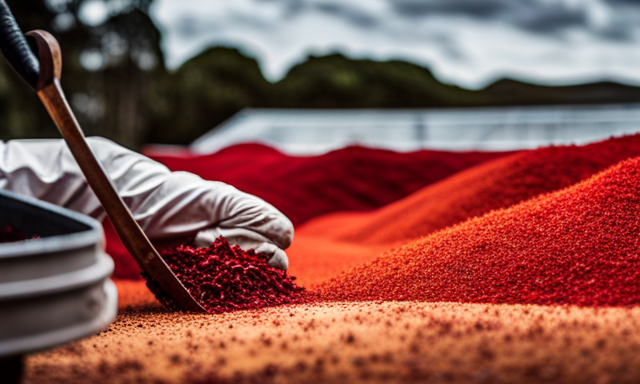I know what you’re thinking – another article about tea? But hear me out, because this one is different. Today, I want to dive into the world of herbal teas and explore the unique characteristics of two popular varieties: honeybush and rooibos.
Now, you might be wondering, how are these two teas different from each other? Well, my friend, that’s exactly what we’re here to uncover.
In this article, we’ll take a deep dive into the origins, flavor profiles, health benefits, and culinary uses of both honeybush and rooibos. We’ll also discuss their sustainability and environmental impact, because let’s face it, we all want to make choices that are good for the planet.
By the end, you’ll have a clear understanding of what sets these two teas apart and be equipped to make an informed decision on which one suits your taste buds and lifestyle. So, grab a cup of your favorite brew and let’s embark on this tea-filled journey together.
Key Takeaways
- Culinary uses: Honeybush can be incorporated into cakes, cookies, muffins, syrups, spirits, sauces, marinades, ice cream, yogurt, granola, and energy bars, while rooibos is commonly infused into teas, used in cocktails, fruit punches, flavored water, smoothies, creams, milk, and desserts.
- Flavor profile: Honeybush offers a subtle honey-like sweetness and floral notes, while rooibos has an earthy and slightly sweet flavor profile. Honeybush is known for its fruity taste, while rooibos is nutty.
- Sustainability: Both honeybush and rooibos are grown using sustainable farming practices, promote soil health and biodiversity, require minimal irrigation, and help prevent soil erosion and degradation. There is minimal use of pesticides or synthetic fertilizers in their cultivation.
- Health benefits: Honeybush is rich in antioxidants and may boost the immune system and help fight inflammation. Rooibos contains polyphenols, aids in digestion, and may improve heart health. Both teas offer potential health benefits, but personalized advice from a healthcare professional should be sought.
Origins and Cultivation of Honeybush and Rooibos
Did you know that honeybush and rooibos, two popular herbal teas, have different origins and are cultivated in unique ways?
Honeybush, scientifically known as Cyclopia, is native to South Africa’s Eastern and Western Cape provinces. It thrives in the fynbos biome, a vegetation type characterized by shrublands and heathlands.
The honeybush plant is cultivated through a careful process that involves collecting and germinating seeds, nurturing seedlings in a greenhouse, and eventually transplanting them to fields.
On the other hand, rooibos, also known as Aspalathus linearis, originates from the Cederberg region in South Africa’s Western Cape province. It grows naturally in the wild and is harvested by hand during the summer months.
The differences in honeybush cultivation and rooibos origins contribute to the distinct flavors and aromas of these two herbal teas. Speaking of flavors, let’s now delve into the unique flavor profiles of honeybush and rooibos.
Flavor Profiles of Honeybush and Rooibos
Explore the delightful nuances of these two South African herbal teas and discover how their flavor profiles create a distinct experience for your taste buds.
Honeybush and rooibos, although similar in many ways, have unique characteristics that set them apart.
Honeybush offers a sweet and fruity flavor with hints of honey and citrus, while rooibos is known for its earthy and nutty undertones.
The brewing techniques for these teas also differ slightly. Honeybush is best steeped for 5-7 minutes in boiling water, while rooibos can be steeped for a shorter time, around 3-5 minutes.
Transitioning into the subsequent section about the health benefits of honeybush, it is fascinating to see how these distinct flavor profiles contribute to the overall goodness of this herbal tea.
Health Benefits of Honeybush
Improve your overall well-being and indulge in a cup of this South African herbal tea, as you discover the impressive health benefits that honeybush has to offer. Not only does honeybush tantalize your taste buds with its naturally sweet and slightly floral flavor, but it also provides a range of health benefits.
Honeybush is known for its digestive benefits, as it aids in soothing digestive discomfort and promoting healthy digestion. It contains antioxidants like phenolic compounds, which help to reduce inflammation and protect against cell damage. Additionally, honeybush is rich in vitamins and minerals that support skin health, such as vitamin C and zinc. These nutrients contribute to a radiant complexion and may even help to combat the signs of aging.
Incorporating honeybush into your daily routine can truly transform your well-being. As we delve into the health benefits of rooibos, you’ll discover even more reasons to embrace these South African herbal teas.
Health Benefits of Rooibos
Rooibos tea is not only a rich source of antioxidants and minerals, but it also offers several health benefits. One of the potential advantages of rooibos tea is its positive impact on digestive health. It has been found to soothe upset stomachs and promote regular bowel movements.
Furthermore, rooibos tea is believed to have benefits for skin health. Some studies have suggested that it may help improve the appearance of acne and other skin conditions.
Incorporating rooibos tea into your daily routine can be a simple and effective way to support your overall well-being.
High in antioxidants and minerals
Honeybush is packed with antioxidants and minerals, making it a powerhouse of health benefits.
Like rooibos, honeybush is one of the antioxidant-rich beverages and mineral-rich herbal teas.
Antioxidants help protect our bodies from harmful free radicals, which can cause oxidative stress and damage to our cells. By consuming honeybush, we can boost our antioxidant intake and support our overall health.
Additionally, honeybush is a great source of minerals such as iron, potassium, calcium, and magnesium. These minerals are essential for various bodily functions, including maintaining healthy bones, promoting proper muscle function, and supporting heart health.
With its impressive antioxidant and mineral content, honeybush offers a natural and delicious way to enhance our well-being.
Moving forward, let’s explore the potential digestive and skin health benefits of honeybush.
Potential digestive and skin health benefits
As we have already discussed, honeybush and rooibos are both rich in antioxidants and minerals, making them excellent choices for promoting overall health. However, honeybush offers additional benefits for both digestion and skin health. When it comes to digestion, honeybush has been known to soothe the digestive system and relieve common issues such as indigestion and bloating. This is due to its natural anti-inflammatory properties. Furthermore, honeybush contains compounds that have been shown to promote healthy skin, helping to reduce inflammation and improve the appearance of acne and eczema. To better understand the unique benefits of honeybush and rooibos, take a look at the following comparison table:
| Honeybush | Rooibos |
|---|---|
| Soothes digestive system | Rich in antioxidants |
| Promotes healthy skin | Relieves stress |
| Anti-inflammatory properties | Enhances sleep quality |
Now that we have explored the potential digestive and skin health benefits of honeybush, let’s move on to learn about the preparation and brewing methods for this delightful tea.
Preparation and Brewing Methods for Honeybush
To fully experience the delightful flavors of honeybush, it’s important to know the proper preparation and brewing methods. Honeybush brewing techniques vary depending on personal preference, but there are a few general guidelines to follow.
Firstly, use freshly boiled water that has been allowed to cool slightly, around 200°F (93°C). Steep the honeybush tea for about 5 to 7 minutes to extract the full flavor. This longer steeping time allows the unique honey-like taste to develop fully. However, if you prefer a milder flavor, you can reduce the steeping time.
Honeybush also comes in different flavor variations, such as plain, citrus-infused, or spiced. Experimenting with different flavors can add a delightful twist to your tea experience.
Now, let’s move on to the preparation and brewing methods for rooibos.
Preparation and Brewing Methods for Rooibos
Get ready to embark on a flavor-filled journey with rooibos. It offers a multitude of brewing techniques and preparation methods that will leave your taste buds dancing.
When it comes to preparing rooibos, the infusion techniques are quite versatile. You can steep it just like you would with traditional tea, using hot water and steeping it for around 5-7 minutes. For a stronger flavor, increase the steeping time.
Another option is to cold brew rooibos. Simply steep it in cold water for several hours, resulting in a refreshing and smooth beverage.
If you’re feeling adventurous, try using rooibos in cooking or baking to add a unique twist to your recipes.
Now, let’s move on to explore the culinary uses of honeybush.
Culinary Uses of Honeybush
One can discover the diverse possibilities of incorporating honeybush into various culinary creations, adding a delightful twist to traditional recipes. Honeybush can be used in baking to infuse desserts with its unique flavor profile. It imparts a subtle honey-like sweetness and floral notes that complement cakes, cookies, and muffins. Additionally, honeybush can be used to create flavorful cocktails. Its aromatic qualities make it an excellent ingredient for infusing syrups or steeping in spirits, resulting in refreshing and distinct beverages. To showcase the culinary versatility of honeybush, here is a table showcasing some creative uses:
| Culinary Use | Description |
|---|---|
| Baking | Incorporate honeybush into cakes, cookies, and muffins for added flavor. |
| Cocktails | Use honeybush in syrups or steep in spirits to create unique drinks. |
Moving on to the culinary uses of rooibos, it offers its own set of possibilities for enhancing dishes and beverages.
Culinary Uses of Rooibos
When it comes to culinary uses, Rooibos offers a variety of possibilities. One of my favorite ways to enjoy Rooibos is by infusing it into beverages. The earthy and slightly sweet flavor of Rooibos adds depth to hot or iced teas, cocktails, and even smoothies.
Additionally, Rooibos can be used in both savory dishes and desserts, providing a unique and delicious twist. From marinades and braises to cakes and cookies, Rooibos adds a subtle but distinct flavor that is sure to impress.
Rooibos-infused beverages
Imagine savoring a warm cup of rooibos-infused tea. Its rich, earthy aroma envelops your senses, transporting you to a place of tranquility and relaxation.
Rooibos, with its versatile flavor profile, can be used to create a wide range of delightful beverages. From refreshing rooibos-infused cocktails to soothing rooibos tea blends, there is something to suit every taste and occasion.
Rooibos can be mixed with fruit juices, herbs, and even spirits to create unique and flavorful cocktails that are perfect for parties or gatherings.
For those looking for a more calming experience, rooibos can be blended with other herbal teas like chamomile or lavender. This creates a soothing and aromatic blend that promotes relaxation and well-being.
Transitioning into the subsequent section about ‘rooibos in savory dishes and desserts’, the culinary uses of rooibos extend beyond beverages. It adds a delightful twist to both sweet treats and savory dishes.
Rooibos in savory dishes and desserts
Picture yourself indulging in the delectable combination of rooibos-infused flavors in both savory dishes and desserts.
Rooibos, with its unique earthy and slightly sweet taste, can add a delightful twist to your main courses. Imagine a succulent roast chicken marinated in a rich rooibos glaze, or a hearty stew infused with the warm, aromatic notes of this South African herbal tea.
And let’s not forget about desserts! Incorporating rooibos into baked goods can take your treats to a whole new level. From rooibos-infused cakes and cookies to creamy rooibos ice cream, the possibilities are endless.
The natural sweetness and complexity of rooibos make it a versatile ingredient that can elevate any dish.
Now, let’s delve into the sustainability and environmental impact of these fascinating teas.
Sustainability and Environmental Impact
To truly understand the sustainability and environmental impact of honeybush and rooibos, let’s take a moment to dive into the fascinating world of these two flavorful teas.
Both honeybush and rooibos are grown using sustainable farming practices that prioritize environmental conservation.
In terms of sustainable farming, both teas are cultivated without the use of pesticides or synthetic fertilizers, ensuring a minimal impact on the ecosystem. Additionally, the production of honeybush and rooibos promotes soil health and biodiversity, as these plants naturally enrich the soil and provide a habitat for various species.
On the environmental conservation front, honeybush and rooibos farming often takes place in regions where water is scarce. However, these teas require minimal irrigation, reducing water consumption compared to other crops. Furthermore, the cultivation of honeybush and rooibos helps to prevent soil erosion and degradation.
Understanding the sustainable farming practices and positive environmental impact of honeybush and rooibos sets the stage for making an informed choice between these two delightful teas.
Choosing Between Honeybush and Rooibos
When deciding between honeybush and rooibos, it’s essential to consider their unique flavors and health benefits. Both teas have their own distinct characteristics that make them appealing to different individuals.
Honeybush has a sweet and fruity taste, while rooibos is known for its earthy and nutty flavor.
In terms of health benefits, honeybush is rich in antioxidants, which are known to help boost the immune system and fight inflammation.
On the other hand, rooibos contains polyphenols that may aid in digestion and improve heart health.
Ultimately, the choice between honeybush and rooibos comes down to personal preference and the specific health benefits one is seeking.
Whether you prefer the fruity sweetness of honeybush or the earthy richness of rooibos, both teas offer unique flavors and potential health benefits.
Frequently Asked Questions
Can honeybush and rooibos be grown in the same climate?
Yes, honeybush and rooibos can be grown in the same climate. Both plants thrive in similar conditions, such as warm temperatures and well-drained soil. In terms of taste, honeybush has a slightly sweeter and more floral flavor compared to rooibos.
Are there any caffeine-free alternatives to honeybush and rooibos?
Yes, there are caffeine-free alternatives to honeybush and rooibos. These alternatives offer similar health benefits, such as antioxidant properties and soothing effects. Some options include chamomile, peppermint, and herbal blends.
What are the differences in antioxidant content between honeybush and rooibos?
The differences in antioxidant content between honeybush and rooibos are minimal. Both teas offer similar health benefits, such as boosting the immune system and reducing inflammation. However, honeybush has a sweeter, fruity taste compared to rooibos.
Can honeybush and rooibos be blended together for a unique flavor profile?
Blending honeybush and rooibos creates a tantalizing flavor profile that is both unique and delicious. Not only does it offer a delightful taste experience, but it also combines the health benefits of both teas.
What is the shelf life of honeybush and rooibos, and how should they be stored to maintain freshness?
The shelf life of honeybush and rooibos can vary, but generally, they can be stored for up to two years if kept in a cool, dark, and airtight container. To maintain freshness, avoid exposure to moisture, heat, and light.
Conclusion
In conclusion, both honeybush and rooibos are unique and flavorful herbal teas that offer a range of health benefits.
Honeybush has a sweet, honey-like taste and is known for its calming effects.
Rooibos, on the other hand, has a slightly nutty and earthy flavor and is praised for its antioxidant properties.
Interestingly, a study conducted by the South African Medical Research Council found that rooibos has the ability to reduce the risk of heart disease by lowering blood pressure and cholesterol levels.
So, if you’re looking for a delicious and healthy beverage, give honeybush and rooibos a try!










